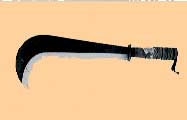January 27, 2006
The Incident of the Falling Bullet - 1
There are memes that periodically surface, much like urban legends. One of these is the Killer Falling Bullets: if you fire your weapon upwards, the free-falling bullet will have enough energy to kill or injure someone unlucky enough to get hit.
A while ago on LGF, talking about the upteenth Palestinian shooting-in-the-air party, one commenter wrote something like "Look at the bright side: the falling bullets will kill some of their own children!" I won't comment on the callousness of such statement, but concentrate on the technical and scientific aspects of the issue.
What kills or injures is the kinetic energy of the bullet, energy that is proportional to the mass of the bullets, but also to the square of its velocity: halving the velocity of a bullet will reduce its kinetic energy by a factor four.
The best way to reach a conclusion would be an experimental campaign: firing upwards with a Kalashnikov, and measuring the energy of the returning bullets. But I lack the facilities, and most sadly I lack a Kalashnikov, so I'll try with a mathematical model.
A body falling through air experiences to opposing forces: the gravitational force pulling downwards and the aerodynamic drag directed upwards. The gravitational force remains more or less constant during the entire flight - unless your bullet goes several kilometers up - but the drag force is proportional to the square of velocity: when these two forces balance out, the bullet stops accelerating and falls at a constant limit velocity.
The gravitational force (aka weight) is straightforward to calculate, while drag depends from the atmospheric properties and the shape and size of the falling body. Density and viscosity of air are known, as is the size of a 7.62mm bullet; its shape is a more difficult problem because without the stabilization given by the rifling the projectile will exhibit an irregular motion. However I am confident I can find a proper estimate for the drag coefficient - in the next part. For now, here's an article written by competent people dealing with a closely related problem.
A while ago on LGF, talking about the upteenth Palestinian shooting-in-the-air party, one commenter wrote something like "Look at the bright side: the falling bullets will kill some of their own children!" I won't comment on the callousness of such statement, but concentrate on the technical and scientific aspects of the issue.
What kills or injures is the kinetic energy of the bullet, energy that is proportional to the mass of the bullets, but also to the square of its velocity: halving the velocity of a bullet will reduce its kinetic energy by a factor four.
The best way to reach a conclusion would be an experimental campaign: firing upwards with a Kalashnikov, and measuring the energy of the returning bullets. But I lack the facilities, and most sadly I lack a Kalashnikov, so I'll try with a mathematical model.
A body falling through air experiences to opposing forces: the gravitational force pulling downwards and the aerodynamic drag directed upwards. The gravitational force remains more or less constant during the entire flight - unless your bullet goes several kilometers up - but the drag force is proportional to the square of velocity: when these two forces balance out, the bullet stops accelerating and falls at a constant limit velocity.
The gravitational force (aka weight) is straightforward to calculate, while drag depends from the atmospheric properties and the shape and size of the falling body. Density and viscosity of air are known, as is the size of a 7.62mm bullet; its shape is a more difficult problem because without the stabilization given by the rifling the projectile will exhibit an irregular motion. However I am confident I can find a proper estimate for the drag coefficient - in the next part. For now, here's an article written by competent people dealing with a closely related problem.
Comments:
Post a Comment


